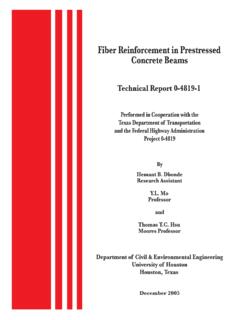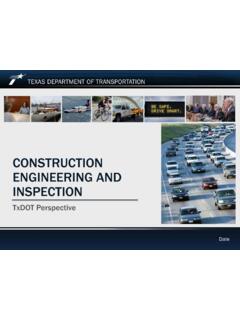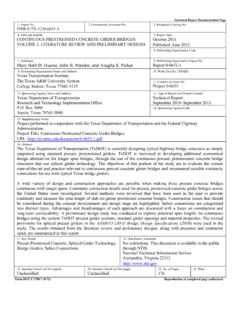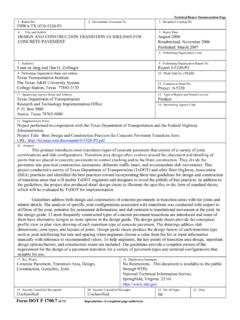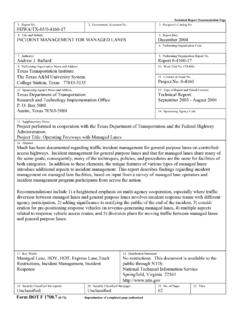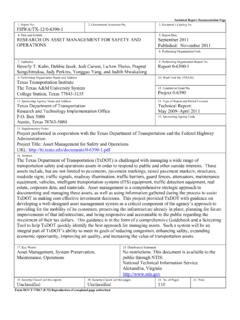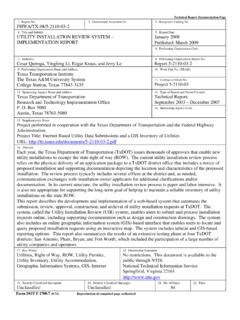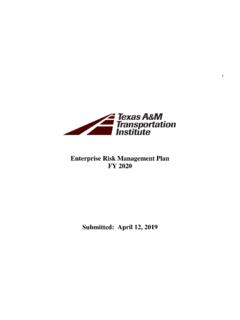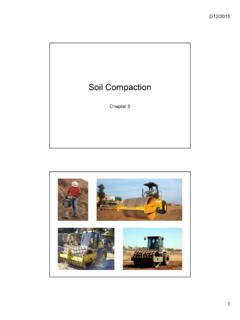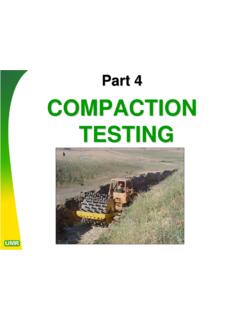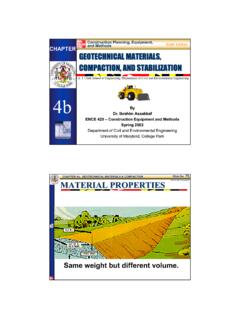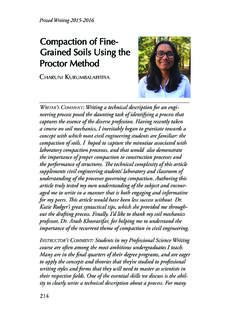Transcription of Improving Lab Compaction Specifications for Flexible Bases ...
1 Technical Report Documentation Page 1. Report No. FHWA/TX-09/0-5135-3 2. Government Accession No. 3. Recipient's Catalog No. 4. Title and Subtitle Improving LAB Compaction Specifications FOR Flexible Bases WITHIN THE TEXAS DOT 5. Report Date October 2008 Published: April 2009 6. Performing Organization Code 7. Author(s) Stephen Sebesta, Wenting Liu, and Pat Harris 8. Performing Organization Report No. Report 0-5135-3 9. Performing Organization Name and Address Texas Transportation Institute The Texas A&M University System College Station, Texas 77843-3135 10. Work Unit No. (TRAIS) 11. Contract or Grant No. Project 0-5135 12. Sponsoring Agency Name and Address Texas Department of Transportation Research and Technology Implementation Office P.
2 O. Box 5080 A ustin, Texas 78763-5080 13. Type of Report and Period Covered Technical Report: September 2006-August 2008 14. Sponsoring Agency Code 15. Supplementary Notes Project performed in cooperation with the Texas Department of Transportation and the Federal Highway Administration. Project Title: Improving Correlation between Field Construction of Soils and Bases and Laboratory Sample Construction Techniques URL: 16. Abstract In Test Methods Tex-113-E and Tex-114-E, the Texas Department of Transportation (TxDOT) employs an impact hammer method of sample Compaction for laboratory preparation of road base and subgrade materials for testing. In this third and final report documenting efforts to improve the relationship between laboratory material Compaction and field construction, Texas Transportation Institute (TTI) researchers present results from efforts to identify whether TxDOT should require Modified Proctor Compaction for Bases , and whether TxDOT should modify its existing laboratory Compaction methods to improve the state-of-the-art.
3 Efforts to evaluate whether a shift to Modified Proctor was warranted proved unfruitful due primarily to a lack of interest and lack of participation from field offices. However, prior work in this project and prior in-house investigations by TxDOT indicate little incentive exists for TxDOT to require Modified Proctor for its base materials. An immediate technique to enhance the state-of-the-art of sample Compaction within TxDOT is to implement the Soil Compactor Analyzer (SCA) system developed in this project. The SCA permanently installs onto the laboratory automatic tamper and enables calibration of the applied Compaction energy along with real-time monitoring of the important operating parameters of the tamper during the sample construction process. 17.
4 Key Words Compaction , Laboratory Compaction , Vibratory Compaction , Tex-113-E, Modified Proctor 18. Distribution Statement No restrictions. This document is available to the public through NTIS: National Technical Information Service Springfield, Virginia 22161 19. Security Classif.(of this report) Unclassified 20. Security Classif.(of this page) Unclassified 21. No. of Pages 36 22. Price Form DOT F (8-72) Reproduction of completed page authorizedIMPROVING LAB Compaction Specifications FOR Flexible Bases WITHIN THE TEXAS DOT by Stephen Sebesta Associate Transportation Researcher Texas Transportation Institute Wenting Liu, Assistant Research Scientist Texas Transportation Institute and Pat Harris, Associate Research Scientist Texas Transportation Institute Report 0-5135-3 Project 0-5135 Project Title.
5 Improving Correlation between Field Construction of Soils and Bases and Laboratory Sample Construction Techniques Performed in cooperation with the Texas Department of Transportation and the Federal Highway Administration October 2008 Published: April 2009 TEXAS TRANSPORTATION INSTITUTE The Texas A&M University System College Station, Texas 77843-3135 DISCLAIMER The contents of this report reflect the views of the authors, who are responsible for the facts and the accuracy of the data presented herein. The contents do not necessarily reflect the official view or policies of the Federal Highway Administration (FHWA) or the Texas Department of Transportation (TxDOT). This report does not constitute a standard, specification , or regulation. The researcher in charge was Stephen Sebesta.
6 V ACKNOWLEDGMENTS This project was conducted in cooperation with TxDOT and FHWA. The project directors, Mike Arrellano, , and Caroline Herrera, , and program coordinator, Miles Garrison, , provided guidance in the direction of the project, along with the following advisors: Tracy Monds, Glenn Eilert, Chris Starr, Lucio Trujillo, and Mike Young. vi TABLE OF CONTENTS Page List of Figures .. viii List of Tables .. ix Executive Summary ..1 Chapter 1. Evaluating the Need for Modified Proctor Compaction for Texas base Materials ..3 Summary ..3 Field Efforts to Investigate Compactive Energy ..3 Historical Perspective on the Development of Tex-113-E ..4 Conclusions ..6 Chapter 2. Improving Laboratory Compaction Methods with the Automatic Tamper.
7 7 Summary ..7 Alternative Methods to 113-E Compaction ..7 Improving Tex-113-E with the Soil Compactor Analyzer ..9 Conclusions ..13 Chapter 3. Evaluating Compactors with the SCA ..15 Summary ..15 Data from Multiple Labs ..15 Discussion ..20 Recommendation ..21 Chapter 4. Conclusions and Recommendations ..23 Summary ..23 Conclusions Regarding Lab Techniques ..23 Recommended Future Efforts ..24 References ..25 vii LIST OF FIGURES Figure Page Moisture-Density Curves for FM 899 base ..4 Prototype Lab Vibratory Compactor ..7 Air Voids in Groesbeck 113-E (Left) and Vibratory (Right) Specimens ..8 Air Voids in Spicewood 113-E (Left) and Vibratory (Right) Specimens.
8 9 Example Displacement Waveform from Automatic Tamper Operation ..10 Primary Components of the Soil Compactor Analyzer ..11 Hammer Parameters Annotated on Hammer Waveform ..12 Compact and Bounce Determination from Hammer Waveform ..13 Average Applied Energy and Drop Height for Five Labs ..16 Average Applied Energy for Each Lift from Five Labs ..16 Frost Dry Density vs. Compactive Effort ..19 Moisture Content after Soaking vs. Dry Density ..20 viii ixLIST OF TABLES Table Page Gradation of FM 899 base ..4 Gravimetric Density Analysis from Groesbeck and Spicewood Flex Bases ..9 TTI s Results from Frost base ..17 Dataset of Varying Effort on Frost base ..18 Summary of Varying Compactive Effort on Frost base ..18 EXECUTIVE SUMMARY In Test Methods Tex-113-E and Tex-114-E, the Texas Department of Transportation (TxDOT) employs an impact hammer method of sample Compaction for laboratory preparation of road base and subgrade materials for testing.
9 Tex-113-E applies to base materials and requires approximately 41 percent of the compactive energy specified by ASTM D 1557, or Modified Proctor. This third and final report documents efforts to validate and finalize recommendations for Improving the laboratory Compaction methods TxDOT uses for aggregate base materials. Specifically, this report describes efforts to finalize recommendations on whether TxDOT should require Modified Compaction energy for its base materials, and this report describes recommendations on how TxDOT should modify its laboratory methods to improve the quality of lab Compaction results. Prior work to evaluate the need for specifying Modified Compaction instead of Tex-113-E energy did not provide compelling evidence to warrant the change.
10 Similarly, the additional efforts described in Chapter 1 of this report did not yield results suggesting TxDOT should initiate an across-the-board shift to Modified Proctor. For Improving lab Compaction methods, Chapter 2 of this report describes alternative techniques investigated. Of available methodologies studied, implementation of the Soil Compactor Analyzer (SCA) provides the most immediate method for Improving TxDOT s laboratory Compaction procedure. The SCA can quantify the applied Compaction energy and produce a record of the compactor s operation for each lab sample constructed, making the system applicable for both calibration and quality control of the automatic tampers employed by the test procedure. Chapter 3 summarizes some initial data collected with the SCA from compactors used in industry.
